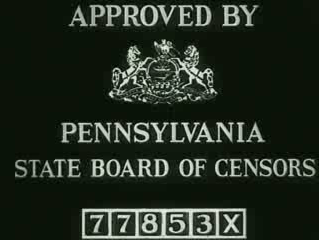Pennsylvania State Board of Censors

The Pennsylvania State Board of Censors was an organization under the Pennsylvania Department of Education responsible for approving, redacting, or banning motion pictures which it considered "sacrilegious, obscene, indecent, or immoral", or which might pervert morals.
Organization
The board was composed of three members, which were appointed by the Governor of Pennsylvania. Despite a censorship law passed in 1911, due to lack of funding it did not begin its activities until 1914.[1]
Destruction
In 1956 the Supreme Court of Pennsylvania ruled the act which created and provided for the board was unconstitutional, with respect to the Pennsylvania Constitution, and so revoked the mandate for the board's existence. The Pennsylvania General Assembly reenacted the statute in 1959, but it was struck down again in 1961 by the Pennsylvania Supreme Court.[2]

See also
- British Board of Film Censors
- Film censorship in the United States
- Indian Film Censor Board
- List of Pennsylvania state agencies
- Maryland State Board of Censors
References
- ^ Harris Ross (2008). "THE PENNSYLVANIA STATE BOARD OF CENSORS: THE GREAT WAR, D. W. THE MOVIES, AND GRIFFITH". Pennsylvania History: A Journal of Mid-Atlantic Studies. 75 (2). The Pennsylvania Historical Association: 227–259.
- ^ Laura Wittern-Keller, “All the Power of the Law: Governmental Film Censorship in the United States”, in Silencing Cinema: Film Censorship around the World, eds. Daniel Biltereyst & Roel Vande Winkel (NY: Palgrave MacMillan, 2013).
- ^ Smith, Frederick James (Oct 1922). "Foolish Censors". Photoplay. 22 (5). New York: 40. Retrieved Dec 3, 2013.
External links
- Page on the Department of Education from the State Archives
- The Public Domain film which the above image came from
